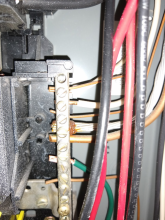ArthurEld
Solar Wizard
Guys, my main electrical panel wiring is a scary tangled up mess.
Since I am adding a Reliance transfer switch I will be adding a lot more wires and wire nuts.
It doesn't help that I have minimal electrical experience.
But, I am going to clean up the mess and I am going to add my new wires neatly.
Here is one of the better examples I have found and there are many good examples.
I picked this one because it shows extra wire neatly coiled up and tucked away. I am hesitant to cut all of my transfer switch wires off but I probably just need to get over that and cut the wires.
My neutrals and grounds go to both sides. I guess it doesn't matter but it looks like crap.
Another thing that concerns me is that my main breaker is at the bottom. The wires for everything I want to do typically come in from the bottom.
But I am not sure if bringing in so many wires from the bottom is best.
I guess I am not the only one who thinks it should be neat and organized in there.
Please share any advice or links that are helpful
This is what I would like mine to look like

Since I am adding a Reliance transfer switch I will be adding a lot more wires and wire nuts.
It doesn't help that I have minimal electrical experience.
But, I am going to clean up the mess and I am going to add my new wires neatly.
Here is one of the better examples I have found and there are many good examples.
I picked this one because it shows extra wire neatly coiled up and tucked away. I am hesitant to cut all of my transfer switch wires off but I probably just need to get over that and cut the wires.
My neutrals and grounds go to both sides. I guess it doesn't matter but it looks like crap.
Another thing that concerns me is that my main breaker is at the bottom. The wires for everything I want to do typically come in from the bottom.
But I am not sure if bringing in so many wires from the bottom is best.
I guess I am not the only one who thinks it should be neat and organized in there.
Please share any advice or links that are helpful
This is what I would like mine to look like

Last edited:






